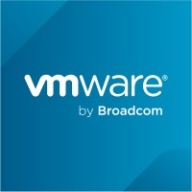

Features: VMware Aria Operations specializes in predictive analytics, capacity management, and integration with VMware platforms for performance optimization. It provides insights into resource usage, helping to optimize and make informed decisions. VMware vSphere offers comprehensive virtualization management, supporting high scalability and complex configurations. Its notable features include vMotion for seamless workload mobility and high availability to ensure uptime.
Room for Improvement: VMware Aria Operations could enhance customization options and streamline user experience for more intuitive navigation. Expanding integration capabilities with non-VMware solutions would increase its versatility. VMware vSphere could improve upon its initial setup complexity and provide more built-in user guidance. Additionally, offering more cost-efficient licensing options could benefit smaller organizations.
Ease of Deployment and Customer Service: VMware Aria Operations is known for its straightforward cloud-based deployment, enabling rapid implementation. Its customer support is praised for proactive engagement, ensuring smooth operation. VMware vSphere, with a more complex setup process, provides versatile deployment options, including hybrid solutions, and is backed by technical customer support known for its expertise in virtualization issues.
Pricing and ROI: VMware Aria Operations is appreciated for its budget-friendly pricing model, delivering substantial ROI through operational efficiency and resource optimization. VMware vSphere, while generally requiring a higher initial investment, justifies this with a high ROI, achieved through infrastructure consolidation, high availability, and reduced hardware expenses.
We can say 10% is the approximate amount of savings because most of the things are automated and streamlined, so the manual work is eliminated in most cases.
They remain in the top 25% of vendors.
I rate the customer service and support for VMware very highly, at nine out of ten.
I would rate technical support around eight or nine.
Priority one issues are usually addressed by engineers within one to two hours.
Recently, support has been less friendly and slower, especially after the company was acquired by Broadcom.
If we have issues, the support tends to be unreliable
I consider VMware Aria Operations to be very scalable, earning a high rating of nine out of ten.
I find VMware Aria Operations to be quite scalable for my needs.
Scaling is easy, whether it is hyperconverged or a three-tier architecture.
VMware vSphere is highly scalable in terms of the number of users and the number of servers it can handle.
It is a highly scalable solution.
The solution is not very stable.
I find the stability of VMware Aria Operations to be impressive, rated as a stable nine out of ten.
It is a stable solution, which is one of the reasons people prefer it since everyone knows how to use it.
It is a very stable hypervisor solution.
While they are generally stable, if outages occur, they tend to be due to brands like HP or Dell, not VMware vSphere itself.
Mostly we don't have issues, but sometimes we have faced some stability issues because of some bugs and some CPU compatibility issues with Intel CPUs.
Stability is a significant area that needs improvement as I experience frequent disconnections and interruptions in data collection.
Customers have commented on the pricing issues, noting that doubling the price is not normal.
One area that needs improvement is the solution's connectivity and integration with other products, such as IBM and Huawei servers and storage.
The cost changed from perpetual to subscription, and there is a need for alternative solutions.
Another area is the stability during upgrades from older versions to newer versions, where we face issues.
Sometimes, it is difficult to find documentation for specific tools and solutions.
The pricing and cost of VMware Aria Operations increased significantly after Broadcom acquired VMware.
This makes the cost complex to determine individually.
VMware Aria Operations is considered overpriced.
Many customers are trying to avoid it due to its high cost.
Costs significantly increased from perpetual to subscription, with prices rising by two to three times over three to five years.
The solution is too expensive.
It allows me to perform deep monitoring and logging of the entire environment, providing a quick alarm and warning system through email.
The valuable features of VMware Aria Operations include the single pane of glass for all my environments, which allows a deep dive into the metrics.
The most valuable features of VMware Aria Operations are its stability, ease of use, and extensive range of features.
The vMotion feature is beneficial for online migration of virtual machines from one host to another without downtime.
The tool is highly available, which is crucial for implementing critical applications requiring 24/7 availability.
I always use VMware vSphere vMotion; we work with this feature all the time. vMotion is very useful; that's why we use the virtualization.
| Product | Market Share (%) |
|---|---|
| VMware Aria Operations | 30.7% |
| IBM Turbonomic | 13.0% |
| Nutanix Prism | 13.0% |
| Other | 43.3% |
| Product | Market Share (%) |
|---|---|
| VMware vSphere | 16.8% |
| Proxmox VE | 16.1% |
| Hyper-V | 15.2% |
| Other | 51.89999999999999% |


| Company Size | Count |
|---|---|
| Small Business | 62 |
| Midsize Enterprise | 62 |
| Large Enterprise | 278 |
| Company Size | Count |
|---|---|
| Small Business | 174 |
| Midsize Enterprise | 137 |
| Large Enterprise | 256 |
VMware Aria Operations is a high-ranking virtualization management and cloud management tool that automates and simplifies IT management to the applications it supports. It achieves this through full-stack visibility from physical, virtual, and cloud infrastructure. The product allows users to enable self-driving IT operations management across private, hybrid, and multi-cloud environments. This is conducted with the unified operations platform that delivers continuous performance, capacity and cost optimization, and integrated compliance through artificial intelligence (AI) and machine learning (ML), and predictive analytics.
VMware Aria Operations Use Cases
VMware Aria Operations has several use cases, some of which include:
VMware Aria Operations Features
The product has various features which users can utilize. Several of the features that the 2022 version of VMware Aria Operations introduced include:
VMware Aria Operations Benefits
VMware Aria Operations brings various benefits to the organizations using it. Among them are the following:
Reviews from Real Users
Mohamed N., a tech lead VMware support engineer at a tech services company, appreciates VMware Aria Operations because it is easy to use, stable, and support is always available.
Mojtaba K., a senior system administrator at a comms service provider, values VMware Aria Operations due to the fact that its dashboards give you a glimpse of what is really going on in your virtualized environment.
VMware vSphere is a versatile virtualization platform known for its ease of use, flexibility, and high availability. It supports seamless migration, optimal resource allocation, and centralized management, making it highly suitable for diverse infrastructure needs.
VMware vSphere is widely adopted for its virtualization capabilities that enhance hardware efficiency and ensure minimal downtime through features like High Availability and Distributed Resource Scheduler. Despite criticisms about high licensing costs and limited fault tolerance, it remains a preferred choice due to its stability, scalability, and robust integration options. Users appreciate its efficiency in managing virtual machines and hosting enterprise applications, although challenges with web client performance and hardware compatibility are noted. Organizations often look for better integration with cloud services and enhanced automation and scalability.
What are the core features of VMware vSphere?
What benefits and ROI can businesses look for?
VMware vSphere is implemented across sectors like healthcare, finance, and education for server virtualization, data center management, and private cloud creation. Its use in facilitating business-critical operations ensures high availability and efficient resource use, supporting both development and production environments.
We monitor all Virtualization Management Tools reviews to prevent fraudulent reviews and keep review quality high. We do not post reviews by company employees or direct competitors. We validate each review for authenticity via cross-reference with LinkedIn, and personal follow-up with the reviewer when necessary.